saxonian
now browsing by tag
antique
beer
blue
ceramic
character
eagle
early
edition
etched
faience
figural
german
germany
gerz
gift
glass
glazed
hand
king
large
lidded
limited
liter
lithophane
made
mettlach
military
munich
oktoberfest
original
painted
pewter
porcelain
rare
regimental
relief
remy
scene
stein
steins
stoneware
tall
tankard
vintage
westerwald
Antique German Saxonian Glass Biedermeier Beer Stein Hand-Blown Stone Cut d. 1840

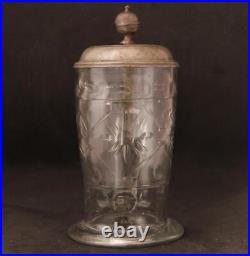


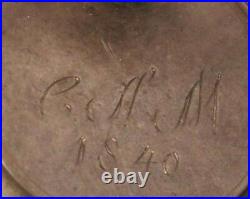
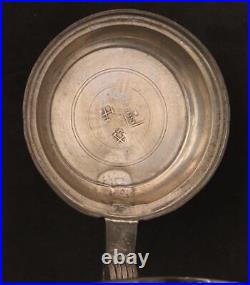

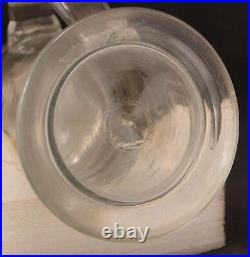

Antique German Saxonian Biedermeier Glass Beer Stein Hand Blown Stone Cut dat. A classical German glass beer stein from the period of late Biedermeier 1820s – to 1850s. Beer steins made before 1850 fall into the “early” category – they were made in pre-industrial period using manual techniques and old technologies. Blown crystal glass with applied thick handle scrolled. Wide pedestal with large pontil mark. Hollow ball thumblift and large five-ring closed type hinge – all typical for the late Biedermeier period. The stein was hand-blown and elaborately stone-cut to create facets and decorations for a beautiful optical effect. This type of glass beer steins were made in the German state of Saxony in 1820s-1850s. They’re usually called the “wedding steins” because the majority of them were made as wedding gifts – they were expensive, nicely decorated and useful – a perfect wedding gift. The lid is engraved with the intials C. That means the stein was made on or before this date – I guarantee my description and dating. It is marked with pewter markings that belong to Carl Gotthold Breitfeld – a pewterer in Annaberg (Saxony) who opened his shop in 1820 and died in 1869. Excellent flawless condition of the glass, the thumblift on the pewter is bent. Nice very typical beer drinking vessel over 180 years old! I guarantee my dating. 9.25 tall to the top of the thumblift, about 1 L capacity. Please note that the glass beer steins are perfectly safe to use for their purpose – to drink beer! Condition: Glass excellent, thumblift bent. Height: 9.25 in. Get images that make Supersized seem small. Track Page Views With.

Antique Early Pewter Engraved German Beer Stein Walzenkrug Saxonian dat. 1785

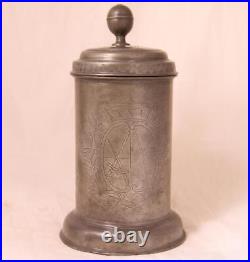
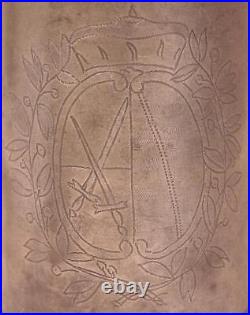
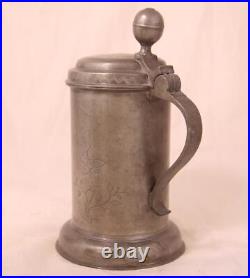
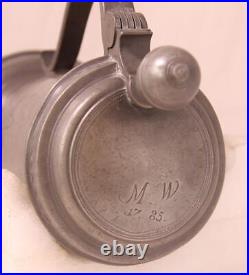
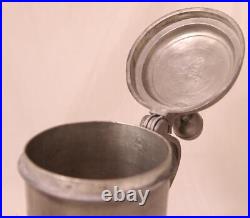
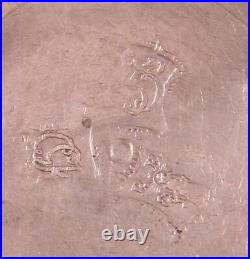



Antique Early Pewter Engraved German Beer Stein Walzenkrug Saxonian dat. Description: This very interesting and impressive beer stein was made in Germany in the early 1800s. It is a so-called “Walzenkrug” – a cylindrical form beer drinking vessel that was very popular in 1700s. The thumblift is a hollow ball – please note that the hollow balls for the thumblift is a very good sign of authenticity. They never made solid balls for the thumblift before 1850 – 1860 and there is no repros with hollow balls – I guess it is very hard to reproduce. The form of the base and the lid is usually associated with Saxonian pewter tradition. The stein is elaborately engraved all over. It has a large Saxonian Coat-of-Arms engraved on the front with Saxonian Royal crown and floral de corations on the sides. Beautiful and skillful work of art. The lid is engraved with initials M. It is fully marked with pewterer’s and town marks for Carl Gottfried Klemm jr. A pewterer who became master in 1758 and inherited the shop from his father who established it in 1708 in Reichenbach, Saxony. I have provided a sc an of his pewter touch marks from the E. Hintze monumental work on German pewter marks see my last pic. The stein is in incredibly good condition – it has some very minimal dings but no damage whatsoever – a rare condition for beer steins this old. It is practically impossible to fake the touch marks of a real pewterer from the period. I have been collecting beer steins for many years and I can stand behind my words. The stein is large and impressive, it is 9 tall, about 1L capacity. Title: Antique Pewter German Beer Stein Wlazenkrug Saxonian c. Get images that make Supersized seem small. Track Page Views With.

Antique Pewter Engraved German Beer Stein Walzenkrug Saxonian c. 1804

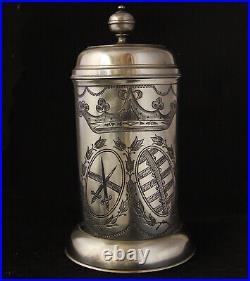
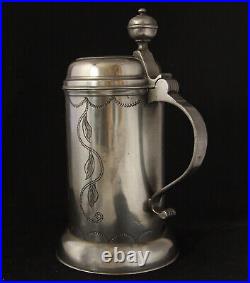

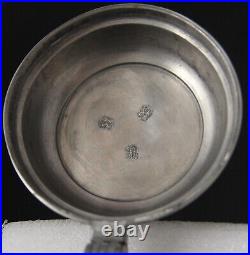




Antique Pewter Engraved German Beer Stein Walzenkrug Saxonian c. Description: This very interesting and impressive beer stein was made in Germany in the early 1800s. It is a so-called “Walzenkrug” – a cylindrical form beer drinking vessel that was very popular in 1700s. The thumblift is a hollow ball – please note that the hollow balls for the thumblift is a very good sign of authenticity. They never made solid balls for the thumblift before 1830 – 1840 and there is no repros with hollow balls – I guess it is very hard to reproduce. The form of the base and the lid is usually associated with Saxonian pewter tradition. The stein is elaborately engraved all over. It has a large Saxonian Coat-of-Arms engraved on the front with Saxonian Royal crown and floral de corations on the sides. Beautiful and skillful work of art. The lid is engraved with initials Chr. It is fully marked with pewterer’s and town marks for Gottfried August Krause – a pewter shop established in 1778 in Dresden, Saxony. I have provided a sc an of his pewter touch marks from the E. Hintze monumental work on German pewter marks see my last pic. The stein is in incredibly good condition – it has some very minimal dings but no damage whatsoever – a rare condition for beer steins this old. Don’t get fooled by the shiny appearance – the stein is really original, including the engraving. It was kept very carefully and polished by the previous owners to resemble silver. It is practically impossible to fake the touch marks of a real pewterer from the period. I have been collecting beer steins for many years and I can stand behind my words. The stein is large and impressive, it is 10.5 tall, over 1L capacity. Height: 10.5 in. Title: Antique Pewter German Beer Stein Wlazenkrug Saxonian c. Auctiva offers Free Image Hosting and Editing. Track Page Views With. This item is in the category “Collectibles\Breweriana, Beer\Drinkware, Steins\Lidded Steins\Germany”. The seller is “beer-stein” and is located in this country: US. This item can be shipped worldwide.

 D5 Creation
D5 Creation